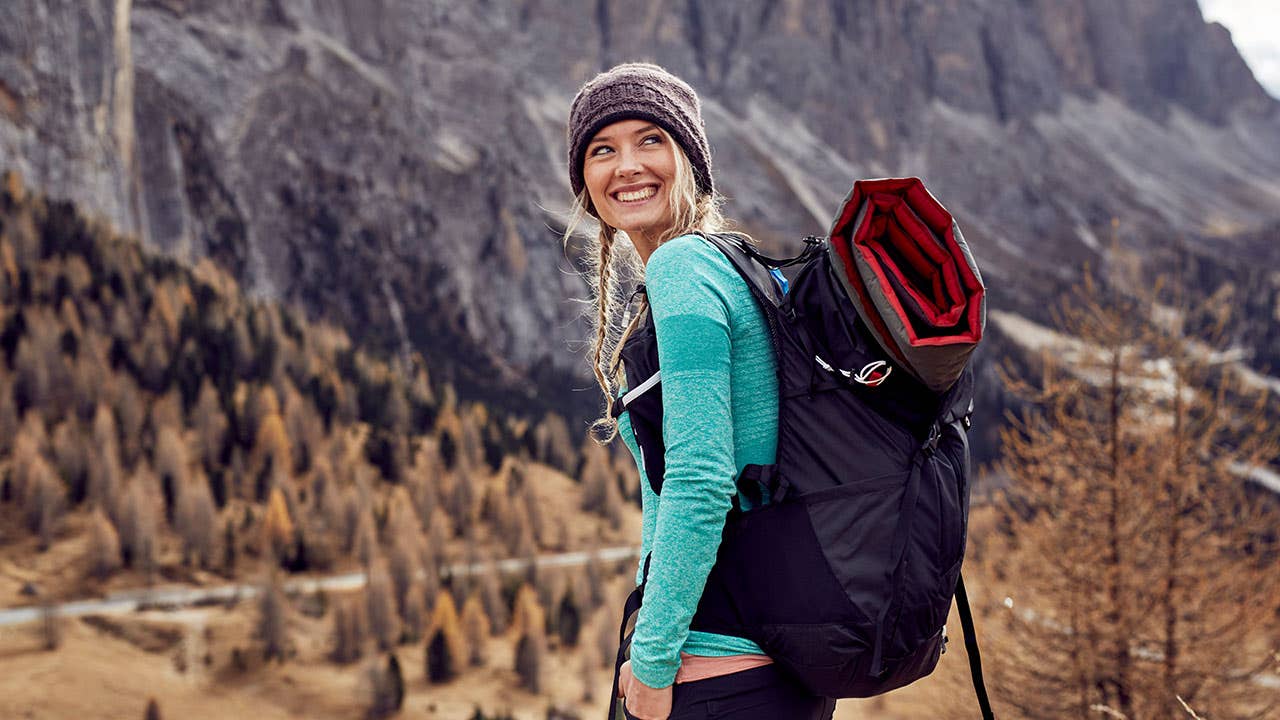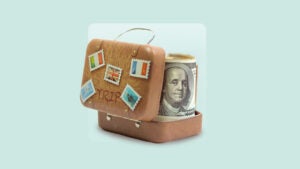Solo female travel: How to keep yourself and your finances safe

Whether you’re flying to Denver on business or to Puerto Vallarta for pleasure, women face unique challenges while traveling solo. Safety concerns are certainly top of the list for many, but financial risks shouldn’t be ignored. For instance, if you’re pickpocketed or misplace your wallet while traveling alone, you’ll be on your own to deal with the fallout.
That said, don’t let the fear of financial missteps stop you from looking into solo trips for women. There are many steps you can take to safeguard your money and your identity while traveling. Read on for ways to fund your adventures, protect your finances, stave off theft and stay safe as you enjoy all the world has to offer.
Solo female travel statistics
- Nearly two-thirds of travelers today are women (GW School of Business)
- 19 percent of female travelers are likely to plan solo trips, compared to 30 percent of male travelers (Travel Pulse)
- In 2019, nearly 32 million American women traveling alone completed solo trips (Travel Industry Association)
- 58 percent of Millennials would take a solo trip, compared to 47 percent of all American adults (Princeton Survey Research Associates)
- Flexibility is the leading motivation for solo female travelers taking worldwide trips (Statista)
- Local culture is the primary reason solo female travelers select their destinations; safety and local crime rates round out the top three factors (Statista)
Safeguarding your money while traveling
Taking precautions to keep your money safe while traveling helps you make the most out of your adventures. After all, the last thing you’ll want to deal with while traveling solo is loss or theft.
Before you even finish packing your suitcase, take the following steps:
- Write down the phone numbers you’ll need to call if your cards are lost or stolen
- Alert your credit card company that you’ll be traveling (some issuers don’t require this anymore, but it’s always good to check)
- Make at least three sets of copies of your bank account information, credit cards and passport (if you’ll be traveling internationally)
- Leave one set of copies with a friend or family member, upload one set to a secure site and carry one set with you, separate from your actual credit cards and passport
- Set up digital wallet options such as Apple Pay and Samsung Pay ahead of time, if you’re eligible to do so
The best travel credit cards can help you protect your money while traveling, as many of them offer travel insurance coverage, rental car insurance, free checked bags, digital wallets and emergency assistance. Know the benefits of your individual cards before heading out on a solo trip.
Once you arrive at your destination, there’s another set of precautions you’ll want to take.
For example, it’s smart to limit the amount of cash you carry. Never take more than what you need for the day, and leave extra cash in a secure spot in your hotel or hostel. If you have more than one debit or credit card with you, secure them in several different places, including in the hotel safe and on your person. If you get pickpocketed, this ensures you have other sources of money in reserve.
Don’t carry an open purse or bag filled to the brim with money or valuables — this is like sticking a bull’s-eye directly on your back. Even better, invest in a handbag with an anti-theft locking zipper. Consider attaching your cards and money to your body so they’re completely out of reach, and get an RFID-blocking wallet, which scrambles EMV chip card scanners (high-tech pickpockets use this to lift credit card data from passersby in public places).
“I keep one credit card, my passport and a day’s worth of cash in a wallet in my zippered pocket or sling handbag. Another credit card and form of identification, copies of my passport and credit cards and most of my cash are in a cotton money belt that is secure around my waist and inaccessible under my clothing,” says Stacey Wittig, travel journalist for UnstoppableStacey.com. “In a third stash, which I keep hidden inside my suitcase or backpack, is another credit card, a small amount of emergency cash and additional copies of my passport and credit cards.”
If you must visit an ATM at your destination, choose one that’s well-lit and monitored by surveillance cameras or by security personnel. Check for an illegal skimmer or, better yet, find an ATM inside a bank. Try to complete your transaction as quickly as possible, all the while protecting your PIN. After you pull your money out of the ATM, quickly store your cash in your secured purse or on your body.
“When checked into hotel rooms or cruise ship cabins, I leave the waist wallet locked in the safe. Then if someone grabs my handbag, the perp gets only one-third of my loot. If they make off with the stash that includes my passport, then I have copies to take to the Embassy,” Wittig says.
Protecting your identity while traveling
That said, it isn’t just your money that you need to be concerned about. Protecting your identity while traveling is just as important.
Many of the steps described above — such as either carrying credit cards, passports or document copies on your person or storing them in a safe — help to protect your identity as well as your money. However, a few other steps you may want to take include:
- Avoiding the use of public Wi-Fi networks and USB charging ports, as they can be easily compromised, making any personal information you transmit across them accessible to malicious actors
- Leaving unnecessary devices at home — and ensuring that any you do bring with you are secured by a strong password
- Deleting unnecessary apps that have sensitive information before traveling (remember, you can always reinstall them when you return home)
- Turning on two-factor authentication wherever possible, including on your email, financial and medical accounts
Depending on your situation, looking into identity theft insurance may be worthwhile. Some travel insurance policies include an identity theft rider, as do some credit cards. Take the time to research any policies you may be covered by. If you need additional coverage, look into standalone policies — the cost of one will almost certainly be less than recovering from an identity theft incident.
What to do if your information is compromised
If you reach for your credit card or debit card and notice your wallet is completely gone, try not to panic. Remember, if you’ve taken the steps described above, you should have your card issuer’s number written down. Here’s what you need to do next to protect your accounts:
- Cancel your credit cards/debit cards. The Fair Credit Billing Act and Electronic Fund Transfer Act state that you won’t be responsible for any charges after you report a card missing, so contact your issuers as soon as possible.
- Address any cash-access issues. Hopefully, you’ve stashed another credit card or debit card back at the hotel or on your person. You may have also set up digital wallet options like Apple Pay, Samsung Pay or other programs that will enable you to access cash without your physical cards.
- Consider freezing your credit. This prevents someone from opening another account in your name. All three credit bureaus make it easy to establish a freeze online, and you can always unfreeze it later.
If your passport has been lost or stolen, here’s how to rectify your situation:
- First, report your passport lost or stolen to the U.S. Department of State to protect yourself from identity theft.
- You will have to replace your passport before reentering the United States. Contact the nearest embassy or consulate for assistance.
- You’ll need to obtain a photo for your replacement passport. You can be directed by the embassy or consulate and may have to have one prior to arrival at the consular section.
- If you’ve been the victim of a serious crime, tell a consular officer. They’ll be able to assist you.
Protecting yourself as a solo traveler
No matter what type of accommodation or type of transit you choose, do your research ahead of time and maintain an awareness of your surroundings when you’re on the ground. Safety can be a concern, whether you’re in the U.S. or abroad. Collectively, most seasoned solo female travelers offer up one specific piece of advice: Trust your gut.
Accommodation safety
There are many important factors to consider when booking accommodations. Before you leave, research the options at your destination and read customer reviews. In particular, look for those with positive reviews from solo female travelers — and, for added safety, book an airport transfer from your hotel or hostel so you know you’ll be transported directly to where you’re staying.
Gemma Thompson, travel blogger for GirlsThatTravel.com, says that she also looks up a particular hotel or hostel address on Google Street View before she books it. “This shows me instantly if the location is safe, on a well-lit street, and it also allows me to familiarize myself with the area so I can recognize it when I arrive, which is helpful if I’m tired or jet-lagged,” she says.
Kristen Slizgi, who manages a travel concierge business, The Luxury Travelist, says that nowadays, many hostels offer smaller, more intimate ways to stay at their properties, such as private rooms. These types of accommodations provide two essential things: a bit of privacy and a platform to meet other like-minded individuals.
“I have many women traveling for the first time tell me that they are a bit hesitant staying in a hostel, especially women who have surpassed their college years and want a bit more privacy,” she says. “As much as I love Airbnb, I still advocate for a hostel stay because of the social atmosphere you get. If I ever find myself traveling alone, I tend to book private rooms in a hostel. It’s still inexpensive and I have a gateway into meeting others and exploring a new place with a new friend.”
Key takeaways
- Invest in a portable alarm door stop which slows someone opening your door and sounds an alarm when someone tries to open it
- When staying at a hostel, keep your valuables (including your cash, passport and documents) in your pillowcase while you sleep to make them less accessible to would-be thieves
- If you’re staying in a hotel or hostel with a safe, store your valuables there while you’re out and about
- To deter hotel staff/thieves from entering your room while you’re out, keep the TV on and your “Do Not Disturb” sign on your door to make it seem as if it’s occupied
- Don’t tell strangers where you are staying
- Consider women-only rooms or floors at hostels
Transit safety
It’s important to be wary when using public transit systems, especially as a solo woman traveler at night. If you do have to travel at night, walk on crowded or brightly lit streets.
Be on the lookout for unlicensed taxis and mini buses, which aren’t bound by local transportation regulations and are notorious for price-gouging, confidence schemes and muggings. Instead, services such as Uber and Lyft keep track of your route and driver and are likely to result in fewer instances where your safety is at risk.
Rebecca Hall, travel writer for LifeBeyondBordersBlog.com, says it’s important to not “look” like a tourist when using public transportation. “Keep your camera hidden, don’t wear ‘touristy’ clothes that make you stand out, such as trainers with socks or a big hat,” she says. “Don’t look at a map in a busy environment — go to a coffee shop and plan out your route.”
Alisha Ruud, owner of RuudAttitude.com, says to avoid phone distractions whenever possible. “Check your routes and connections prior to using transit. If possible, keep the information on paper or take a screenshot on your phone. Pull this up when you feel it’s necessary, but don’t keep it out at all times,” she recommends. “Enjoy the transit! It’s great for immersing yourself in the culture and learning more about the area you are in.
Ruud and Hall offer the following transit safety tips:
- Stay attentive and try to observe what’s around you
- Try to blend in with local transit users
- Always pay attention to your surroundings
- Don’t overshare on social media
- Don’t flaunt your valuables on public transit (or, don’t take valuables with you, period)
COVID-19 safety
Though many coronavirus pandemic travel restrictions have eased, you may still want to take extra precautions whether you choose to travel alone or with a buddy:
- Research your destination: Before takeoff, make sure you know what entry requirements your destination has, if any. A small number of countries still require negative tests before you arrive, a quarantine period once you get there, or proof of COVID-19 vaccination. Depending on your nationality, you may also need to provide a negative test result to re-enter your home country.
- Pack necessities: COVID or not, it’s always a good idea to pack basic sanitation supplies, including hand sanitizer, wipes and masks to keep yourself safe and healthy while traveling.
- Have a backup plan: Know what you’ll do if you catch COVID-19 (or any illness) while you’re away from home. If you’re required to quarantine, for example, you’ll need to have enough emergency funds (or travel points) to cover unanticipated hotel nights or last-minute rental cars to drive yourself home.
Funding your travel adventures
As a solo traveler, you shoulder the entire cost of your trip — there’s no one else to share hotel rooms or split expenses with while you’re away. In some cases, solo travelers are even penalized for their single status. On many cruises, for example, you’ll be required to pay double-occupancy rates for your cabin, even if you’re the only one who will be traveling.
If you want to take more solo trips, finding ways to save money can help you fund even more travel adventures. One way to do this is to find the right credit card for your travel situation. A luxury, high-annual fee card might not make sense if you prefer to stay in hostels, for example, and a co-branded airline card might not fit if you only take road trips. Do your homework, particularly when it comes to foreign transaction fees and purchase protection.
Travel credit cards typically fall into three categories:
Quick definitions
- General purpose travel reward cards
- These cards earn flexible rewards for many types of travel costs, including airfare, rental cars and hotels.
- Co-branded travel reward cards
- If you stay at specific hotels or fly a particular airline often, you’ll receive enhanced rewards through their co-branded cards.
- Premium travel reward cards
- High-end perks and benefits are the reason many frequent travelers go for premium cards. You could get airport lounge access, travel credits and increased rewards earning potential.
See related: How to choose the right travel credit card
Travel blogs and travel groups on social media can also be good sources of information on saving money on solo travel for women. Once you start planning your trip, look for resources that are specific to your destination. Not only will you benefit from money-saving tips and tricks from those that have gone before you, but you may also find unique insights into the expenses that are worth the cost — and those that aren’t.
The bottom line
As long as your iPhone isn’t sticking out of your back pocket in Rome or your expensive SLR camera isn’t dangling around your neck on London’s Tube, solo female travel can be safe, enjoyable and enriching.
Traveling on your own is a great way to gain independence and enjoy new experiences, but as with anything in life, preparation is key. If you aren’t quite ready to make your own way, there are many women travel groups you can join to get your feet wet. Otherwise, do your research ahead of time and take the necessary steps to protect your money and your identity so that you can get the most out of your time away.
You may also like

How a financial therapist can help you with money anxiety

Traveling soon? What to lookout for when exchanging money




